
Contact us
Our team would love to hear from you.
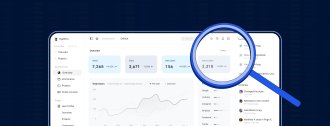
The exponential increase in data volumes has complicated the way information is stored, transferred, shared, and used. To successfully address challenges and capitalize on the value of data, decision-makers are adopting advanced business intelligence tools.
What is BI and how does it work? In this article, we will uncover the essence of business intelligence and explore its life cycle from beginning to end, providing a holistic view of how it works.
Business intelligence involves processing and analyzing data, transforming it into knowledge that organizations can use to make informed decisions. BI uses a combination of analytics, strategy, and technology to help decision-makers develop plans and tactics to drive change and adapt to the market.
Business intelligence software offers invaluable advantages to companies by aiding in data organization, converting data into actionable insights, and predicting market dynamics and future trends based on discernable patterns.
BI tools help businesses improve their offerings, maximize productivity, and accelerate the analysis of information from different sources, thereby boosting data-driven approaches, economic growth, and profitability. To gain a better understanding of the process, let’s delve into the business intelligence workflow.
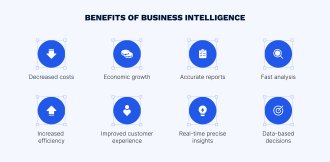

Simply put, BI takes information from different sources and transforms it into convenient and understandable analytics presented in user-friendly views (tables, charts, graphs, histograms, and more). BI uses two types of sources: internal and external.
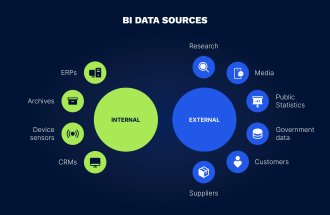

Internal data refers to the enterprise’s information, which is typically stored in databases such as archives, ERPs, CRMs, device sensors, and other company-owned assets. While internal information is the backbone of an organization’s data system, it is not always sufficient.
When internal information does not provide a complete picture, internal data can be supplemented with information from external sources. External sources refers to publicly available data found outside the company’s infrastructure, such as social media, public statistics, research, government data, and more.
Business intelligence is multifaceted and only functions effectively when properly optimized. It is an ongoing process requiring constant evolution to provide relevant, accurate, and meaningful data. To illuminate the essence of BI, we outline below the steps of the BI life cycle.
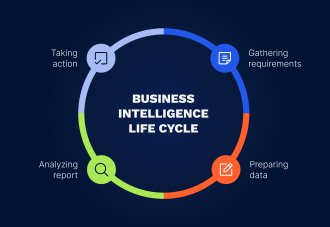

Before deciding on tactics, it is essential to make a robust plan. Start from the finish line to determine what you need to accomplish. Examine business requirements, assess the biggest challenges, and define the purpose of the analysis. What is your priority? What data do you already have? Where is your data coming from? Can the data analysis be automated? How much time is needed to create the insights? This stage is for finding the answers to these questions.
Once the requirements are established, the next step is to design the logical model and physical schema to facilitate data analysis. Following that comes the construction of the data warehouse where the gathered information will be stored.
The data collected from different sources must be consolidated and made available to those who will use it for decision-making. To ensure the reliability of the data, it must be cleaned by removing duplicates and fixing bugs before it is loaded into the BI system.
A business intelligence software development company can help you collect, clean, and load your data, provide you with robust tools, and guide you through the next steps of the BI cycle.
This is where the magic of BI happens. The data that has been aggregated and consolidated into a single place is converted into a visually appealing report that meets the requirements established in the first stage. Interactive dashboards allow stakeholders to communicate the narrative and drill down into market trends, customer experience, business performance, problems, statistics, and other factors, providing valuable insights to enable informed decisions on the organization’s development.
This is where an idea becomes reality. In this stage, you can harness the power of BI systems by creating comprehensive reports covering all areas of interest to business leaders. Leveraging business intelligence software, decision-makers can measure and monitor key performance indicators to align strategy with business objectives.
The last stage of the BI cycle is the iteration of the process. Evaluate the success of your decisions and make adjustments to improve the outcomes, obtain more valuable insights, and take more impactful actions. This could entail a complete reevaluation of the requirements, circling back to the first step and creating an iterative process.
By helping enterprises collect data from myriad sources, consolidate it in a single place, and visualize it in a convenient and consistent way, business intelligence plays a critical role in successful business development. Companies that leverage data to analyze the present and predict future conditions acquire new perspectives and have a competitive advantage over companies that have not yet implemented BI in their processes.
If you are looking for a BI development company, you are in the right place. Contact us today to put your BI plan into action! Our BI developers are ready to help you uncover the power of business intelligence for a better understanding of your organization and data-based decision-making.
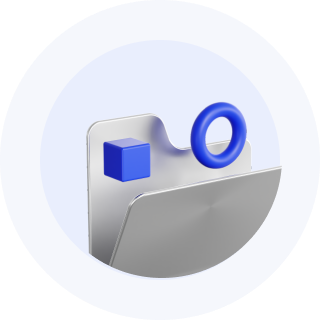
Business Intelligence (BI) is evolving rapidly, driven by technological advancements and changing business needs. One key trend is the rise of augmented analytics, which integrates artificial intelligence (AI) and machine learning (ML) into BI tools to automate data preparation, insight generation, and recommendation processes. This enables organizations to derive actionable insights without requiring advanced technical expertise. Additionally, real-time analytics is becoming increasingly critical as businesses strive to make data-driven decisions instantaneously, particularly in sectors like e-commerce, finance, and healthcare. Another significant trend is the shift toward cloud-based BI solutions, offering scalability, accessibility, and cost-efficiency. These trends collectively aim to make BI more accessible, proactive, and integral to everyday business operations.
Ensuring data security and compliance in BI projects begins with implementing strong governance policies and access controls. Role-based access ensures that users can only view or manipulate data relevant to their responsibilities. Encryption, both in transit and at rest, protects sensitive data from unauthorized access. Compliance with regulations such as GDPR, HIPAA, or industry-specific standards requires regular audits and adherence to best practices. Organizations should also adopt secure cloud services with certifications like ISO 27001 to guarantee data protection. Implementing logging and monitoring systems helps detect and respond to suspicious activities, ensuring continuous security in BI projects.
At EffectiveSoft, we guarantee compliance with data security standards and regulations. For instance, we have recently achieved the updated version of ISO/IEC 27001:2022 certification which assures clients that their sensitive information is handled with the utmost care and in compliance with internationally accepted standards.
Data integration faces challenges such as dealing with disparate data sources, formats, and systems. Mismatched schemas and inconsistent data definitions can cause compatibility issues, complicating the integration process. Data silos within organizations further hinder seamless integration, limiting comprehensive analysis. Scalability is another challenge, especially when handling large volumes of data generated in real time. Ensuring data quality throughout the integration process is critical, as errors can propagate across systems.
Can’t find the answer you are looking for?
Contact us and we will get in touch with you shortly.
Our team would love to hear from you.
Fill out the form, and we’ve got you covered.
What happens next?
San Diego, California
4445 Eastgate Mall, Suite 200
92121, 1-800-288-9659
San Francisco, California
50 California St #1500
94111, 1-800-288-9659
Pittsburgh, Pennsylvania
One Oxford Centre, 500 Grant St Suite 2900
15219, 1-800-288-9659
Durham, North Carolina
RTP Meridian, 2530 Meridian Pkwy Suite 300
27713, 1-800-288-9659
San Jose, Costa Rica
C. 118B, Trejos Montealegre
10203, 1-800-288-9659